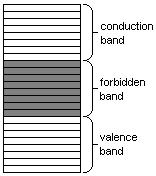
|
This page uses content from the Engineering wiki on Wikia. The original article was at Electrical resistance. The list of authors can be seen in the page history. As with the Units of Measurement wiki, the text of the engineering wiki is available under Creative Commons License see Wikia:Licensing. |
Electrical resistance is a measure of the degree to which an object opposes the passage of an electric current.

A resistor
How measured[]
The SI unit of electrical resistance is the ohm. Its reciprocal quantity is electrical conductance measured in siemens.
What is resistance[]
Resistance is the property of any object or substance of resisting or opposing the flow of an electrical current. The quantity of resistance in an electric circuit determines the amount of current flowing in the circuit for any given voltage applied to the circuit. The relevant formula is:
- R = V / I
where
- R is the resistance of the object, usually measured in ohms.
- V is the potential difference across the object, usually measured in volts, (DC).
- I is the current passing through the object, usually measured in amperes
Characterstic[]
For a wide variety of materials and conditions, the electrical resistance does not depend on the amount of current flowing or the amount of applied voltage. V can either be measured directly across the object or calculated from a subtraction of voltages relative to a reference point. The former method is simpler for a single object and is likely to be more accurate. There may also be problems with the previous method if the voltage supply is AC and the two measurements from the reference point are not in phase with each other.
Resistive loss[]
When a current, I, flows through an object with resistance, R, electrical energy is converted to heat at a rate (power) equal to
where
- P is the power measured in watts
- I is the current measured in amperes
- R is the resistance measured in ohms
This effect is useful in some applications such as incandescent lighting and electric heating, but is undesirable in power transmission. Common ways to combat resistive loss include using thicker wire and higher voltages. Superconducting wire is used in special applications.
Resistance of a conductor[]
DC resistance[]
As long as the current density is totally uniform in the conductor, the DC resistance R of a conductor of regular cross section can be computed as
where
- L is the length of the conductor, measured in meters
- A is the cross-sectional area, measured in square meters
- ρ (Greek: rho) is the electrical resistivity (also called specific electrical resistance) of the material, measured in ohm · meter. Resistivity is a measure of the material's ability to oppose the flow of electric current.
For practical reasons, almost any connections to a real conductor will almost certainly mean the current density is not totally uniform. However, this formula still provides a good approximation for long thin conductors such as wires.
AC resistance[]
If a wire conducts high-frequency alternating current then the effective cross sectional area of the wire available for current conduction is diminished. (See skin effect).
The Terman formula gives the diameter of wire that will suffer a 10% increase in resistance
where
- is the frequency of operation, measured in hertz (Hz)
- is the diameter of the wire in millimeters
This formula applies to isolated conductors. In a conductor in close proximity to other conductors, the actual resistance is higher because of the proximity effect.
Causes of resistance[]
In metals[]
A metal consists of a lattice of atoms, each with a shell of electrons. The outer electrons are free to dissociate from their parent atoms and travel through the lattice, making the metal a conductor. When an electrical potential (a voltage) is applied across the metal, the electrons drift from one end of the conductor to the other under the influence of the electric field. In a real material the atomic lattice is never perfectly regular, so its imperfections scatter the electrons and cause resistance. A rise in temperature causes the atoms to vibrate more strongly, creating even more collisions and increasing the resistance still further.
The larger the cross-sectional area of the conductor, the more electrons are available to carry the current, so the lower the resistance. The longer the conductor, the more scattering events occur in each electron's path through the material, so the higher the resistance. [1]
In semiconductors and insulators[]
Semiconductors have properties that are part-way between those of metals and of insulators. A silicon boule has a grayish metallic sheen, like a metal, but is brittle, like glass. It is possible to manipulate the resistive properties of semiconductor materials by doping those materials with atomic elements, such as arsenic or boron, which create electrons or holes which can move across the material lattice.
In ionic liquids/electrolytes[]
In electrolytes, electrical conduction happens not by band electrons or holes, but by full atomic species (ions) traveling, each carrying an electrical charge. The resistivity of ionic liquids varies tremendously by the salt concentration - while distilled water is almost an insulator, salt water is a very efficient electrical conductor. In cell membranes, currents are carried by ionic salts. Small holes in the membranes, called ion channels, are selective to specific ions and determine the membrane resistance.
Resistance of various materials[]
| Material | Resistivity, ohm-meter |
| Metals | |
| Semiconductors | variable |
| Electrolytes | variable |
| Insulators |
Band theory[]

Electron energy levels in an insulator.
Quantum mechanics states that the energy of an electron in an atom cannot be any arbitrary value. Rather, there are fixed energy levels which the electrons can occupy, and values in between these levels are impossible. The energy levels are grouped into two bands: the valence band and the conduction band (the latter is generally above the former). Electrons in the conduction band may move freely throughout the substance in the presence of an electrical field.
In insulators and semiconductors, the atoms in the substance influence each other such that between the valence band and the conduction band, there exists a forbidden band of energy levels that the electrons simply cannot occupy. In order for a current to flow, a relatively large amount of energy must be furnished to an electron for it to leap across this forbidden gap and into the conduction band. Thus, large voltages yield relatively small currents.
Differential resistance[]
When resistance may depend on voltage and current, differential resistance, incremental resistance or slope resistance is defined as the slope of the V-I graph at a particular point, thus:
This quantity is sometimes called simply resistance, although the two definitions are equivalent only for an ohmic component such as an ideal resistor. If the V-I graph is not monotonic (i.e. it has a peak or a trough), the differential resistance will be negative for some values of voltage and current. This property is often known as negative resistance, although it is more correctly called negative differential resistance, since the absolute resistance V/I is still positive.
Temperature-dependence[]
Near room temperature, the electric resistance of a typical metal conductor increases linearly with the temperature:
- ,
where a is the thermal resistance coefficient.
The electric resistance of a typical intrinsic (non doped) semiconductor decreasesexponentially with the temperature:
As temperature increased starting from absolute zero extrinsic (doped) semiconductors first decrease in resistance as the carriers leave the donors or acceptors then once most of the donors or acceptors have lost their carriers the resistance starts to increase again slightly due to the reducing mobility of carriers (much as in a metal) and then finally start to behave like intrinsic semiconductors as the carriers from the donors/acceptors become insignificant compared to the thermally generated carriers
The electric resistance of electrolytes and insulators is highly nonlinear, and case by case dependent, therefore no generalized equations are given here.
See also[]
- Resistor
- Electrical conduction for more information about the physical mechanisms for conduction in materials.
- voltage divider
- Voltage drop
- current divider
- Thermal resistance
- Electrical resistivity
- SI electromagnetism units
External links[]
- Electric Resistance Converter - converts between various units of electric resistance
- Electric Resistance Conversion Table - converts selected units to all other units
- Electric Resistance Conversion Tool - Converts value to other unit
- Electric Resistivity Converter - converts between various units of electric resistivity
- Electric Resistivity Conversion Table - converts selected units to all other units of electric resistivity
- Calculation: Electrical resistance, voltage, current, and power
- All About Circuits
- EE Power
- Electronics Point
- Maker Pro










